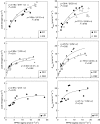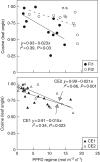Optimal photosynthetic use of light by tropical tree crowns achieved by adjustment of individual leaf angles and nitrogen content
- PMID: 19151040
- PMCID: PMC2707872
- DOI: 10.1093/aob/mcn265
Optimal photosynthetic use of light by tropical tree crowns achieved by adjustment of individual leaf angles and nitrogen content
Abstract
Background and aims: Theory for optimal allocation of foliar nitrogen (ONA) predicts that both nitrogen concentration and photosynthetic capacity will scale linearly with gradients of insolation within plant canopies. ONA is expected to allow plants to efficiently use both light and nitrogen. However, empirical data generally do not exhibit perfect ONA, and light-use optimization per se is little explored. The aim was to examine to what degree partitioning of nitrogen or light is optimized in the crowns of three tropical canopy tree species.
Methods: Instantaneous photosynthetic photon flux density (PPFD) incident on the adaxial surface of individual leaves was measured along vertical PPFD gradients in tree canopies at a frequency of 0.5 Hz over 9-17 d, and summed to obtain the average daily integral of PPFD for each leaf to characterize its insolation regime. Also measured were leaf N per area (N(area)), leaf mass per area (LMA), the cosine of leaf inclination and the parameters of the photosynthetic light response curve [photosynthetic capacity (A(max)), dark respiration (R(d)), apparent quantum yield (phi) and curvature (theta)]. The instantaneous PPFD measurements and light response curves were used to estimate leaf daily photosynthesis (A(daily)) for each leaf.
Key results: Leaf N(area) and A(max) changed as a hyperbolic asymptotic function of the PPFD regime, not the linear relationship predicted by ONA. Despite this suboptimal nitrogen partitioning among leaves, A(daily) did increase linearly with PPFD regime through co-ordinated adjustments in both leaf angle and physiology along canopy gradients in insolation, exhibiting a strong convergence among the three species.
Conclusions: The results suggest that canopy tree leaves in this tropical forest optimize photosynthetic use of PPFD rather than N per se. Tropical tree canopies then can be considered simple 'big-leaves' in which all constituent 'small leaves' use PPFD with the same photosynthetic efficiency.
Figures





Similar articles
-
Contributions of leaf photosynthetic capacity, leaf angle and self-shading to the maximization of net photosynthesis in Acer saccharum: a modelling assessment.Ann Bot. 2012 Aug;110(3):731-41. doi: 10.1093/aob/mcs106. Epub 2012 Jun 4. Ann Bot. 2012. PMID: 22665700 Free PMC article.
-
Spatial distribution of leaf nitrogen and photosynthetic capacity within the foliage of individual trees: disentangling the effects of local light quality, leaf irradiance, and transpiration.J Exp Bot. 2002 Nov;53(378):2207-16. doi: 10.1093/jxb/erf065. J Exp Bot. 2002. PMID: 12379788
-
Interrelationships among light, photosynthesis and nitrogen in the crown of mature Pinus contorta ssp. latifolia.Tree Physiol. 1999 Jan;19(1):13-22. doi: 10.1093/treephys/19.1.13. Tree Physiol. 1999. PMID: 12651327
-
Variation in leaf photosynthetic capacity within plant canopies: optimization, structural, and physiological constraints and inefficiencies.Photosynth Res. 2023 Nov;158(2):131-149. doi: 10.1007/s11120-023-01043-9. Epub 2023 Aug 24. Photosynth Res. 2023. PMID: 37615905 Review.
-
Construction and maintenance of the optimal photosynthetic systems of the leaf, herbaceous plant and tree: an eco-developmental treatise.Ann Bot. 2005 Feb;95(3):507-19. doi: 10.1093/aob/mci049. Epub 2004 Dec 14. Ann Bot. 2005. PMID: 15598701 Free PMC article. Review.
Cited by
-
Effects of photosynthetic models on the calculation results of photosynthetic response parameters in young Larix principis-rupprechtii Mayr. plantation.PLoS One. 2021 Dec 31;16(12):e0261683. doi: 10.1371/journal.pone.0261683. eCollection 2021. PLoS One. 2021. PMID: 34972150 Free PMC article.
-
Functional structure of biological communities predicts ecosystem multifunctionality.PLoS One. 2011 Mar 10;6(3):e17476. doi: 10.1371/journal.pone.0017476. PLoS One. 2011. PMID: 21423747 Free PMC article.
-
Contributions of leaf photosynthetic capacity, leaf angle and self-shading to the maximization of net photosynthesis in Acer saccharum: a modelling assessment.Ann Bot. 2012 Aug;110(3):731-41. doi: 10.1093/aob/mcs106. Epub 2012 Jun 4. Ann Bot. 2012. PMID: 22665700 Free PMC article.
-
A System Dynamics Approach to Model Photosynthesis at Leaf Level Under Fluctuating Light.Front Plant Sci. 2022 Jan 28;12:787877. doi: 10.3389/fpls.2021.787877. eCollection 2021. Front Plant Sci. 2022. PMID: 35154180 Free PMC article.
-
Is analysing the nitrogen use at the plant canopy level a matter of choosing the right optimization criterion?Oecologia. 2011 Oct;167(2):293-303. doi: 10.1007/s00442-011-2011-3. Epub 2011 May 13. Oecologia. 2011. PMID: 21567246 Free PMC article. Review.
References
-
- Amthor JS. Scaling CO2 photosynthesis relationships from the leaf to the canopy. Photosynthesis Research. 1994;39:321–350. - PubMed
-
- Amundson R, Austin AT, Schuur EAG, et al. Global patterns of the isotopic composition of soil and plant nitrogen. Global Biogeochemical Cycles. 2003;17:1030.
-
- Anten NPR, Schieving F, Werger MJA. Patterns of light and nitrogen distribution in relation to whole canopy carbon gain in C3 and C4 mono- and dicotyledonous species. Oecologia. 1995;101:504–513. - PubMed
-
- Björkman O. Responses to different quantum flux densities. In: Lange OL, Nobel PS, Osmond CB, Zeigler H, editors. Encyclopedia of plant physiology. Berlin: Springer-Verlag; 1981. New Series.
-
- Bond BJ, Farnsworth BT, Coulombe RA, Winner WE. Foliage physiology and biochemistry in response to light gradients in conifers with varying shade tolerance. Oecologia. 1999;120:183–192. - PubMed
Publication types
MeSH terms
Substances
LinkOut - more resources
Full Text Sources
Miscellaneous

